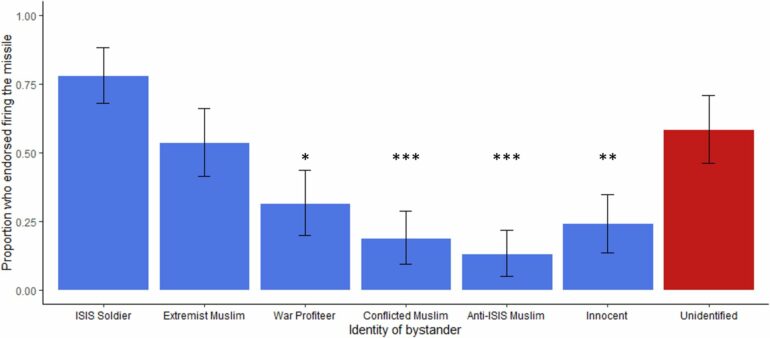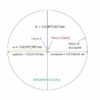People’s bias toward sacrificing unknown bystanders appears to stem from assuming the unidentified person is an enemy, according to a study published October 23, 2024, in the open-access journal PLOS ONE by Scott Danielson from the University of Canterbury, New Zealand, and colleagues.
About as many civilians as soldiers die in war each year, some during strikes targeted at enemy combatants. There have been many reported cases of mistaking innocent civilians for enemy combatants, with the possibility of many more being unreported.
Danielson and colleagues conducted five experiments to test when people assume unknown bystanders in a combat zone are enemies rather than civilians, reducing their concerns about collateral damage. A total of 2,204 participants were presented with a realistic moral dilemma: A military pilot must decide whether to bomb a dangerous enemy target, also killing a bystander.
The first two experiments used as the scenario a conflict between the U.S. and ISIS in Iraq. Here, few people endorsed bombing when the bystander was known to be an innocent civilian. However, when the bystander’s identity was unknown, more than twice as many people endorsed the bombing.
Crucially, approximately half of American participants endorsed sacrificing unidentified bystanders despite no evidence they were enemies—a sacrificial rate higher than any identified target except a known enemy combatant. The subsequent three experiments used a fictional war setting and revealed a similar pattern of judgment was seen here too.
Bombing endorsement was predicted by attitudes toward total war: the theory that there should be no distinction between military and civilian targets in wartime conflict. The authors also noted key differences between the participant samples based on their country—bombing endorsement was lower for participants in the U.K. compared to the U.S., which the researchers attribute to national and cultural differences in total war attitudes.
According to the authors, these findings have implications for military strategists who must decide whether to attack areas with enemy militants and unidentified bystanders. The results support a common tendency in people to assume the bystanders are enemies, with important consequences if they turn out to be innocent civilians.
The real-world cases of civilians struck by bombs could result from the same error in judgment reported in this study. To minimize civilian deaths, future research should investigate how to reduce this bias and convince decision-makers to evaluate more carefully who their weapons are targeting.
The authors add, “Fewer than one in four Americans support a military strike that kills a civilian, but 53% endorse a strike if the bystander is ‘unidentified.’ Data from five studies show that people are more likely to assume unknown bystanders are enemy combatants than civilians, which might explain the high civilian death toll in modern warfare.”
More information:
What I don’t know can hurt you: Collateral combat damage seems more acceptable when bystander victims are unidentified, PLoS ONE (2024). DOI: 10.1371/journal.pone.0298842
Provided by
Public Library of Science
Citation:
Experiments find people assume unidentified bystanders in a war zone are combatants, acceptable collateral damage (2024, October 23)



